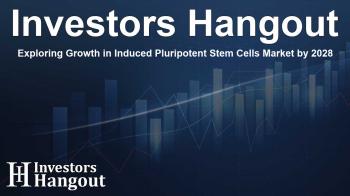Exploring Growth in Induced Pluripotent Stem Cells Market by 2028

Induced Pluripotent Stem Cells Market Overview
The induced pluripotent stem cells (iPSCs) market is undergoing significant transformation, expecting impressive growth in the upcoming years. A recent study outlines that the market is projected to reach a valuation of $5.2 billion by 2028, experiencing a compound annual growth rate (CAGR) of 9.1%. This growth is driven by several factors, many of which revolve around the pressing needs of healthcare and medical research.
Key Drivers of Market Growth
The rise in the prevalence of chronic diseases has created an urgent requirement for innovative treatments. iPSCs play a crucial role in developing therapies for complex conditions such as diabetes and heart disease. Their ability to transform into various cell types makes them integral to research aimed at combating these persistent health issues.
Boost in Biotech Investments
With healthcare taking center stage, both public and private sectors are ramping up their investments in biotechnology. This influx of funding is vital for advancing iPSC research, which holds promise for unlocking new therapeutic options and improving patient outcomes.
Demand for Personalized Medicine
As we shift toward more personalized medicine approaches, iPSCs stand out by enabling treatments tailored to individual genetic profiles. This personalized strategy offers hope for more effective solutions to chronic conditions that often do not respond well to traditional treatments.
Enhancements in Drug Discovery
iPSCs are revolutionizing drug discovery processes. By creating cellular models of diseases, researchers can accurately test new drugs for safety and efficacy before proceeding to human trials. This not only optimizes the drug development pathway but also reduces potential risks involved in clinical trials.
Market Segmentation and Analysis
The BCC Research report segments the iPSC market into various categories based on application types, product functions, and the types of iPSC-derived cells. These segments cover key areas such as drug development, toxicity testing, and regenerative medicine, showcasing the diverse applications of iPSCs.
Types of iPSC-Derived Cells
Different types of cells can be derived from iPSCs, including hepatocytes, neurons, and cardiomyocytes, each serving unique roles in research and therapeutic development. These advancements have expedited the pace of medical discoveries and clinical care improvements.
Challenges and Market Opportunities
While the market experiences robust growth, it is not without its challenges. Factors such as regulatory hurdles and ethical considerations pertaining to stem cell research must be navigated carefully. However, these challenges also present opportunities for companies that can innovate and adapt to new regulatory landscapes.
Emerging Technologies
The report delves into emerging technologies that are reshaping the iPSC landscape. Innovations such as gene editing techniques and advanced culture systems are enhancing the efficacy of iPSC-derived applications, fostering further developments in the research community.
Leading Companies in the iPSC Industry
The landscape is populated by notable leaders in the stem cell industry. Companies like NCARDIA, QIAGEN, and REPROCELL INC. are at the forefront, driving advancements in iPSC research. Their contributions, whether through novel products or cutting-edge research protocols, are crucial in propelling the industry forward.
Strategic Partnerships and Collaborations
Strategic partnerships among companies, research institutions, and regulatory bodies are increasingly pivotal. These collaborations not only enhance resource sharing but also facilitate knowledge transfer, accelerating innovation within the sector.
Conclusion
The outlook for the induced pluripotent stem cells market is promising, with a compound annual growth rate projected at 9.1%. This growth trajectory highlights the increasing recognition of iPSCs' potential in addressing some of the most pressing health challenges of our time. Companies poised to innovate and adapt will be in a strong position to capitalize on this expanding market.
Frequently Asked Questions
What are induced pluripotent stem cells (iPSCs)?
Induced pluripotent stem cells are a type of stem cell that can be generated directly from adult cells, allowing researchers to create various cell types.
Why is the iPSC market expected to grow?
The market is driven by increasing chronic disease prevalence, rising investments in biotechnology, and the demand for personalized medicine.
What applications does iPSC technology have?
Applications include drug discovery, toxicity testing, regenerative medicine, and academic research.
Which companies are leading the iPSC market?
Leading companies include NCARDIA, QIAGEN, and REPROCELL INC., known for their innovative products and research initiatives.
What challenges does the iPSC market face?
Challenges include regulatory hurdles, ethical considerations, and the need for standardized procedures in research and therapy development.
About Investors Hangout
Investors Hangout is a leading online stock forum for financial discussion and learning, offering a wide range of free tools and resources. It draws in traders of all levels, who exchange market knowledge, investigate trading tactics, and keep an eye on industry developments in real time. Featuring financial articles, stock message boards, quotes, charts, company profiles, and live news updates. Through cooperative learning and a wealth of informational resources, it helps users from novices creating their first portfolios to experts honing their techniques. Join Investors Hangout today: https://investorshangout.com/
Disclaimer: The content of this article is solely for general informational purposes only; it does not represent legal, financial, or investment advice. Investors Hangout does not offer financial advice; the author is not a licensed financial advisor. Consult a qualified advisor before making any financial or investment decisions based on this article. The author's interpretation of publicly available data presented here; as a result, they should not be taken as advice to purchase, sell, or hold any securities mentioned or any other investments. If any of the material offered here is inaccurate, please contact us for corrections.
